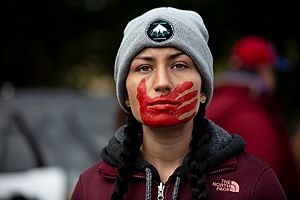Red handprint facts for kids

A red handprint, often painted across the mouth, is a powerful symbol. It shows support for missing and murdered Indigenous women and girls in North America. This symbol helps people remember that Native American women are much more likely to be harmed or go missing.
Contents
How the Red Handprint Started
The red handprint symbol first became well-known because of an athlete named Jordan Marie Daniel. She is a competitive runner from the Kul Wicasa Oyate (Lower Brule Sioux Tribe) in South Dakota.
Jordan Marie Daniel's Run
Jordan Marie Daniel used the symbol at the 2019 Boston Marathon. She ran to honor 26 missing or murdered Indigenous women. She wanted to use her running to make sure these women were seen, heard, and remembered. After this, other athletes like Rosalie Fish also wore the symbol. It has also appeared on billboards and was used by Ilona Verley on the TV show Canada's Drag Race.
What the Red Handprint Means
The red handprint shows that many Indigenous women's voices have been silenced. It highlights that there is often a lack of attention when Indigenous women go missing or are murdered.
Speaking for Those Silenced
In 2020, a news reporter named Rhiannon Johnson shared the story of Michelle Buckley. Michelle, from Hay River, wore the red handprint in photos to honor her sister Rea, who passed away at 14. Michelle said the photos aimed to show that missing and murdered Indigenous women is a big issue. She also said it helped her and others heal.
People Who Wear the Red Handprint
Many people and groups have used the red handprint to raise awareness.
Jordan Marie Daniel and Rosalie Fish
Rosalie Fish is a student and athlete from the Cowlitz Tribe in Washington. She was inspired by Jordan Marie Daniel. Rosalie used her running events to honor missing and murdered Indigenous women. At a state track and field meet, she placed her running medals on a poster. This poster had pictures and names of four Indigenous women who had been murdered.
Ignacio High School Girls Basketball Team
The Bobcats basketball team at Ignacio High School also showed their support. In team photos, each player and the coach wore a red or black handprint. This showed their support for the Missing and Murdered Indigenous Women movement.
Ilona Verley on Canada's Drag Race
Ilona Verley is from the Nlaka'pamux Nation in British Columbia. She was a contestant on the first season of Canada's Drag Race. For her final appearance on the show, Ilona wore a traditional jingle dress. She also wore the red handprint to bring more attention to the issue of missing and murdered Indigenous women. Ilona has continued to use the symbol on social media.
Billboard Campaigns
The Native Justice Coalition created billboards to spread awareness. These billboards show an Indigenous woman with a red handprint across her mouth. They aim to highlight the issue of missing and murdered Indigenous women and Two-spirit people in places like Grand Haven, Michigan. Cecilia Lapointe of the Native Justice Coalition created this billboard campaign.

